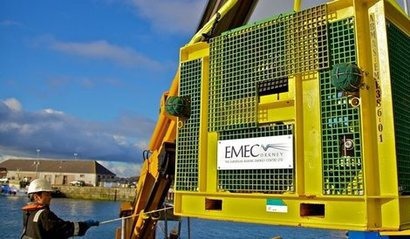
The device was deployed on the seabed at the Fall of Warness tidal energy test site in Orkney, Scotland. It is a first of its kind pre-commercial prototype which is connected to the shore via a subsea cable enabling 24/7 real-time data collection. This has enabled the device to deliver live data feeds back to EMEC which can then be used by marine energy developers using the site. The ongoing project is receiving funding from the Scottish Government via the Marine Renewables Commercialisation Fund (MRCF), which is managed by the Carbon Trust.
“I am delighted that our £2.8 million innovation support programme, part of the Marine Renewables Commercialisation Fund, is funding EMEC's integrated monitoring system” said Scottish Energy Minister, Fergus Ewing. “This has been successfully deployed at the Fall of Warness test site and highlights the role that such enabling technologies will play in the success of the first wave and tidal arrays.”
Angus Vantoch-Wood, Programme Manager of the MRCF at the Carbon Trust added that the Carbon Trust is very pleased to be managing the innovative project and its ongoing delivering on behalf of the Scottish Government. The Carbon Trust believes the device will help to reduce the cost of early array deployments for both wave and tidal technologies.
The bespoke system, designed by EMEC to operate in high velocity tidal flows, integrates a variety of sensors to undertake comprehensive concurrent environmental measurements, providing improved characterisation of high energy marine environments. Making real-time data feeds available to developers will assist in device design, enable more accurate assessment of device performance, and support operations and maintenance planning.
The Pod comprises active sonar, acoustic doppler current profiler (ADCP), passive sonar (hydrophones), and CTD (conductivity, temperature, density,) sensors. This feeds into EMEC’s supervisory control and data acquisition (SCADA) system, which also incorporates data from acoustic drifters, marine radar, meteorological stations, vessel tracking, and wildlife observations across EMEC’s test sites.
It was initially deployed in 2012 as part of the ReDAPT project, funded by the UK Energy Technologies Institute, and gathered data for six months over winter prior to being recovered. Additional funding was awarded from the Scottish Government’s Marine Renewables Commercialisation Fund (MRCF), managed by the Carbon Trust, in 2014 to review the lessons learnt from the initial prototype deployment and support further development of the system for pre-commercial demonstration.
The Pod has been set up as a plug-and-play prototype with the ability to install additional sensors as required, with future development focused on supporting data collection at commercial marine energy array projects. It was deployed in a highly volatile tidal environment but the project has benefitted strongly from a competent local supply chain with the combined experience, ingenuity and seamanship to make such a tricky project run relatively smoothly. These companies have worked with EMEC on many projects throughout the years, thereby making the job a lot easier to manage. However, there has been huge learning cures with the project as EMEC is operating in largely uncharted territory. One of the key discoveries is that certain materials designed for use on offshore subsea operations, such as connectors, are not necessarily suited to cope with highly oxygenated and turbulent near-shore environments.
EMEC will now carry out further inspections and enhancements to the pod prior to redeployment in spring 2016.
For additional information:

